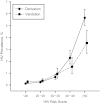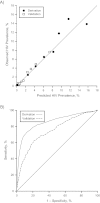Derivation and validation of the Denver Human Immunodeficiency Virus (HIV) risk score for targeted HIV screening
- PMID: 22431561
- PMCID: PMC3390011
- DOI: 10.1093/aje/kwr389
Derivation and validation of the Denver Human Immunodeficiency Virus (HIV) risk score for targeted HIV screening
Abstract
Targeted screening remains an important approach to human immunodeficiency virus (HIV) testing. The authors aimed to derive and validate an instrument to accurately identify patients at risk for HIV infection, using patient data from a metropolitan sexually transmitted disease clinic in Denver, Colorado (1996-2008). With multivariable logistic regression, they developed a risk score from 48 candidate variables using newly identified HIV infection as the outcome. Validation was performed using an independent population from an urban emergency department in Cincinnati, Ohio. The derivation sample included 92,635 patients; 504 (0.54%) were diagnosed with HIV infection. The validation sample included 22,983 patients; 168 (0.73%) were diagnosed with HIV infection. The final score included age, gender, race/ethnicity, sex with a male, vaginal intercourse, receptive anal intercourse, injection drug use, and past HIV testing, and values ranged from -14 to +81. For persons with scores of <20, 20-29, 30-39, 40-49, and ≥50, HIV prevalences were 0.31% (95% confidence interval (CI): 0.20, 0.45) (n = 27/8,782), 0.41% (95% CI: 0.29, 0.57) (n = 36/8,677), 0.99% (95% CI: 0.63, 1.47) (n = 24/2,431), 1.59% (95% CI: 1.02, 2.36) (n = 24/1,505), and 3.59% (95% CI: 2.73, 4.63) (n = 57/1,588), respectively. The risk score accurately categorizes patients into groups with increasing probabilities of HIV infection.
Figures


Comment in
-
Re: "Derivation and validation of the Denver Human Immunodeficiency Virus (HIV) risk score for targeted HIV screening".Am J Epidemiol. 2012 Sep 15;176(6):567-8; author reply 568-9. doi: 10.1093/aje/kws305. Epub 2012 Aug 16. Am J Epidemiol. 2012. PMID: 22899828 Free PMC article. No abstract available.
References
-
- Branson BM, Handsfield HH, Lampe MA, et al. Revised recommendations for HIV testing of adults, adolescents, and pregnant women in health-care settings. MMWR Recomm Rep. 2006;55(RR-14):1–17. - PubMed
-
- Bartlett JG, Branson BM, Fenton K, et al. Opt-out testing for human immunodeficiency virus in the United States: progress and challenges. JAMA. 2008;300(8):945–951. - PubMed
-
- Haukoos JS, Hopkins E, Hull A, et al. HIV testing in emergency departments in the United States: a national survey. Ann Emerg Med. 2011;58(1 suppl 1):S10–S16. - PubMed
-
- Rothman RE, Hsieh YH, Harvey L, et al. 2009 US emergency department HIV testing practices. Ann Emerg Med. 2011;58(1 suppl 1):S3–S9. - PubMed
Publication types
MeSH terms
Grants and funding
LinkOut - more resources
Full Text Sources
Medical
Miscellaneous

